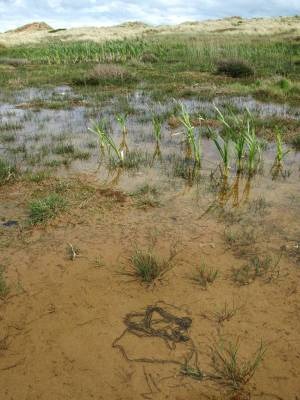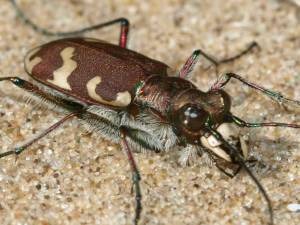Dr Phil Smith’s Wildlife Notes
April 2009
Apart from the last few days, April was dominated by prolonged drought. Indeed, as very little rain has fallen locally since January, we have had one of the driest late winter/spring periods in living memory! This has important consequences for wildlife, especially those species like the Natterjack Toad that are dependent on wetlands. Most of the toad’s breeding areas in the sand-dunes have dried up already. There was some activity on Birkdale Green Beach but my total spawn count was only 102 strings compared with 172 at the end of April last year.

The dry, sunny conditions did benefit some creatures, however, most notably the Vernal Mining Bee (Colletes cunicularius) which is a real Sefton Coast speciality. Listed in the Red Data Books, this species is confined to sand-dunes in northwest England and a few places in Wales. About the same size as a Honey Bee, but stockier and dark-brown, it is a “solitary” bee which forms loose colonies, tunnelling into south-facing dune slopes and busily collecting pollen, mainly from willow catkins. I recorded what seem to be two previously overlooked populations, counting 40 colonies at Crosby Marine Park and 68 at Hall Road, Blundellsands. These are important extensions of the known range of this nationally rare insect.
Even rarer is the spectacular Northern Dune Tiger Beetle (Cicindela hybrida), now found in only two places in Britain. We have over 95% of them on the Sefton Coast and I was delighted to count 30 on the Birkdale Green Beach embryo dunes on 21st April.

Migrant birds always arrive in a rush during April and there is something new to be seen almost every day. On 18th, I went to Seaforth to catch up with my favourite bird, the Little Gull. Only twenty were present but my visit coincided with an Osprey soaring low overhead – a magnificent spectacle! Another local rarity is the Cattle Egret, two of which turned up at Plex Moss on 22nd. However, in a few years time, these could become as common as the rapidly increasing Little Egrets and Avocets. Peak counts of the latter reached 70 at Marshside and 88 at Martin Mere. Northern Wheatears of the large and colourful Greenland race are a feature of late April. A cloudy night grounded large numbers on 24/25th, with over 100 reported at Ravenmeols sand-dunes. I counted 77 during a tour of the mosslands near Formby, where there were also 88 Whimbrel, that smaller relative of the Curlew. Marshside had an excellent assortment of waders from mid-month, including flocks of Black-tailed Godwits and Golden Plovers coming into gorgeous breeding plumage, together with Curlew Sandpiper, Little Stint, Ruff, Snipe, Dunlin, Avocet, Lapwing, Oystercatcher and Redshank. Also present for a few days was a superb Spotted Redshank, living up to its old name the “Dusky” Redshank.
Has anyone heard a Cuckoo? There has been only a handful of reports so far. This formerly common harbinger of spring is approaching extinction in our region, having declined nationally by 59% since 1980. The reasons for this are not fully understood but seem to be connected with food supply, both here and in its African winter quarters. Cuckoos like large hairy caterpillars and there are fewer of those about nowadays, probably because of intensive agriculture.
